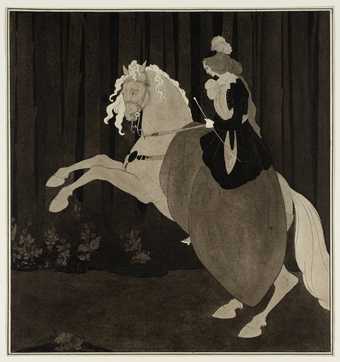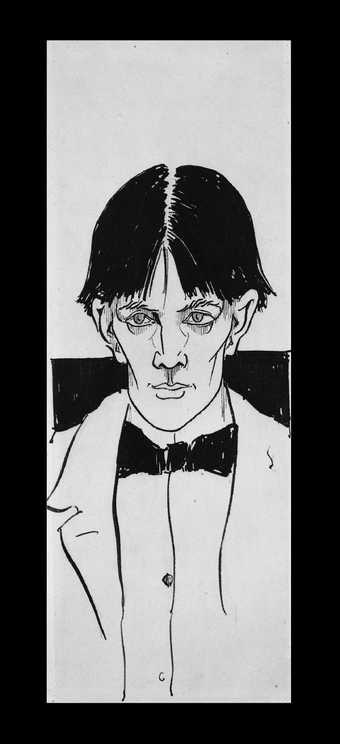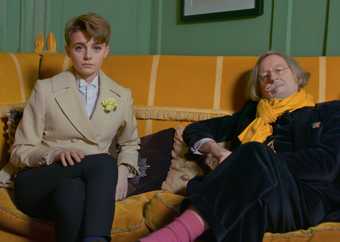Aubrey Beardsley shocked and delighted late-Victorian London with his sinuous black and white drawings. He explored the erotic and the elegant, the humorous and grotesque, winning admirers around the world with his distinctive style.
Spanning seven years, this exhibition covers BeardsleyŌĆÖs intense and prolific career as a draughtsman and illustrator, cut short by his untimely death from tuberculosis.
Exhibition Tour
Join Tate curators Caroline Corbeau-Parsons and Alice Insley as they discuss the iconic illustrator's short and scandalous career.
Few artists have stamped their personality so indelibly on their era as Aubrey Beardsley. He died in 1898 at the age of just 25 but had already become one of the most discussed and celebrated artists in Europe. His extraordinary black-and-white drawings were instantly recognisable. Then, as now, he seemed the quintessential figure of 1890s decadence.
Beginnings
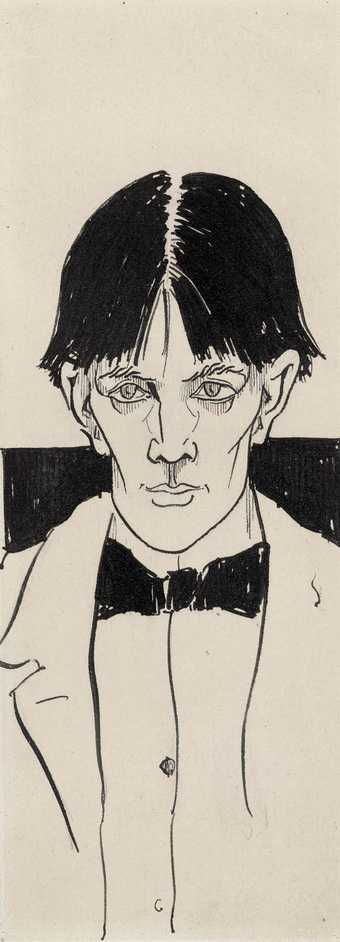
Aubrey Beardsley Self-Portrait 1892 British Museum (London, UK)
BeardsleyŌĆÖs artistic career spanned just under seven years, between 1891 and 1898. When he was 18 he met the Pre-Raphaelite painter Edward Burne-Jones, an artist he deeply admired. Having seen BeardsleyŌĆÖs portfolio, Burne-Jones responded: ŌĆśI seldom or never advise anyone to take up art as a profession, but in your case I can do nothing else.ŌĆÖ On his recommendation, for a short time Beardsley attended classes at Westminster School of Art.
Beardsley longed for fame and recognition. This went hand in hand with an intensely cultivated self-image and pose as a dandy-aesthete. This important aspect of his identity is illuminated through self-portraits and portraits by his contemporaries throughout the exhibition.
Witty, tall, ŌĆśspotlessly clean & well-groomedŌĆÖ, Beardsley was soon noted for his dandyism. A delight in refinement and artificiality in both dress and manner, dandyism was integral to the decadent creed. Some contemporaries related the artistŌĆÖs extreme thinness and fragile physical appearance to ideas of morbidity also associated with decadence. While Beardsley rejected the label of decadence, his work explores many aspects of it, such as a fascination with the ŌĆśanti-naturalŌĆÖ and the bizarre, with sexual freedom and gender fluidity. What present-day society refers to as LGBTQIA+ identities were only just beginning to be formulated and articulated during his lifetime. Beardsley was attracted to women, but he was a pioneer in representing what we might now call queer desires and identities. Though fascinated by all aspects of sexuality, it seems likely that his explorations of these interests were primarily through literature and art.
Le Morte Darthur
In early 1892, Beardsley received his first major commission. His friend, the photographer and bookseller Frederick H. Evans introduced him to J.M. Dent. The energetic and enterprising publisher was looking for an illustrator for Le Morte Darthur, Sir Thomas MaloryŌĆÖs 15th-century version of the legends of King Arthur. Dent planned a substantial edition in the style of William MorrisŌĆÖs Kelmscott Press books. Between autumn 1892 and June 1894 Beardsley produced 353 drawings, including full and double-page illustrations, elaborate border designs and numerous small-scale ornamental chapter headings. He received ┬Ż250 over the course of this commission. This freed him to leave his hated job as a clerk and focus on art-making.
Beardsley gradually grew weary of this colossal undertaking and went off-brief. Subversive details started to appear in his drawings. He also introduced incongruous characters such as mermaids and satyrs, goat-legged hybrid creatures from classical mythology.
His illustrations were reproduced using the relatively new and economical line block printing process in which drawings are transferred onto printing plates photographically. Beardsley was at first disappointed with the printing of his drawings, but he quickly adapted his style to suit the line block process, which uniquely could reproduce both the finest of lines and large, flat areas of black.
The works in this room demonstrate the development of BeardsleyŌĆÖs art over two years, and how he combined many different sources to create his own visual language.
ŌĆśSomething suggestive of JapanŌĆÖ
The European craze for Japanese visual culture had begun in the 1860s after trade links were re-established. Beardsley grew up surrounded by western interpretations of Japanese art. In the summer of 1891, together with his sister Mabel, he visited the London mansion of the shipping magnate Frederick Leyland. There he saw the ŌĆśPeacock RoomŌĆÖ created 15 years earlier by the expatriate American artist James McNeill Whistler. Decorated with borrowed and reworked Japanese motifs, this masterpiece of the aesthetic movement had become one of the most celebrated interiors in London. Mesmerised by his visit, Beardsley began to introduce such details into his own drawings.
Japanese woodblock prints (Ukiyo-e) were also an important influence. Beardsley adopted their graphic conventions. His new style included areas of flat pattern contrasted with precisely drawn figures against abstracted or empty backgrounds. Like several artist at this time, he also favoured the distinctive, tall and narrow format of traditional Japanese kakemono scrolls.
In a letter to a friend, Beardsley bragged, ŌĆśI struck for myself an entirely new method of drawing and composition, something suggestive of Japan ... The subjects were quite mad and a little indecent.ŌĆÖ
A New Illustrator
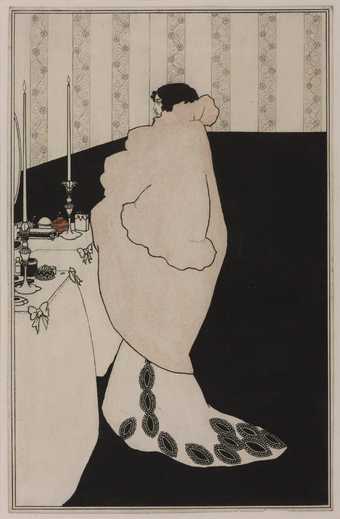
Aubrey Beardsley
La Dame aux Cam├®lias (1894)
Tate
Beardsley first came to public notice in April 1893. He was the subject of the lead article, ŌĆśA New IllustratorŌĆÖ, in the first issue of the new art magazine The Studio. In it, the graphic art expert Joseph Pennell praised BeardsleyŌĆÖs work as ŌĆśquite as remarkable in its execution as in its invention: a very rare combination.ŌĆÖ
Pennell welcomed BeardsleyŌĆÖs use of ŌĆśmechanical reproduction for the publication of his drawingsŌĆÖ. The article highlighted how photographic line-block printing showed the true quality of an artistŌĆÖs line.
The reproductions in The Studio article included both medieval and Pre-Raphaelite style illustrations for the forthcoming Le Morte Darthur and examples of BeardsleyŌĆÖs work inspired by Japanese woodblock prints. This displayed his versatility and led to further commissions for books and popular journals, such as the Pall Mall Magazine. J.M. Dent, the publisher of Le Morte Darthur, rightly worried Beardsley would get bored of that long-term project. To keep him interested, he invited him to create hundreds of tiny ŌĆśgrotesqueŌĆÖ illustrations for the Bon-Mots series, three miniature books of witty sayings. In this context, the term grotesque relates to distortion or exaggeration of form to create an effect of fantasy or strangeness. For Beardsley the idea was central to his way of seeing the world. Summing up his own art, he later said, ŌĆśI am nothing if I am not grotesque.ŌĆÖ
│¦▓╣▒¶┤Ū│Š├®
In 1892, Beardsley made a drawing in response to │¦▓╣▒¶┤Ū│Š├®, Oscar WildeŌĆÖs play, originally written in French and based on the biblical story. │¦▓╣▒¶┤Ū│Š├® falls in love with Iokanaan (John the Baptist). When he rejects her, she demands his head from her step-father, Herod Antipas, as a reward for performing the dance of the seven veils. Beardsley depicts her about to kiss IokanaanŌĆÖs severed head. Wilde admired the drawing and he and his publisher, John Lane, chose Beardsley to illustrate the English translation of the play. The illustrations weave together themes of sensuality and death, and explore a wide range of sexual desires. The playŌĆÖs publication created a sensation, just as Beardsley and Wilde had hoped.
Beardsley delighted in hiding provocative elements in his drawings. Lane recalled, ŌĆśone had, so to speak, to place his drawings under a microscope, and look at them upside downŌĆÖ. Nervously, he censored 'problematic' details in BeardsleyŌĆÖs title page and the illustration Enter Herodias and rejected two designs altogether from the first edition. Even so, Lane missed many erotic details and, surprisingly, also allowed publication of BeardsleyŌĆÖs teasing drawings that include caricatures of Wilde.
Beardsley produced eighteen designs in total, of which only ten appeared in the first printing of the play. The impressions exhibited here come from the portfolio which Lane issued in 1907, almost a decade after BeardsleyŌĆÖs death. This was the first edition to contain all the original designs and an additional one, Salome on Settle.
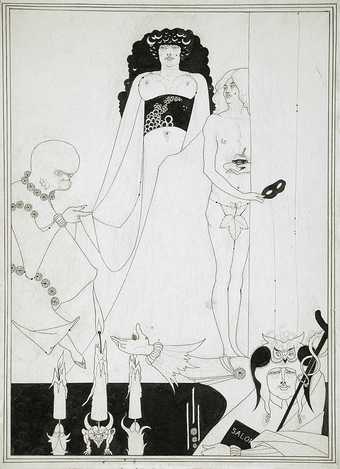
Aubrey Beardsley Enter Herodias 1893 (published 1907) Private Collection
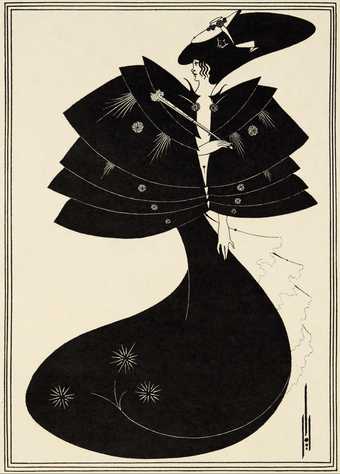
Aubrey Beardsley The Black Cape 1893 Princeton University Library (Princeton, USA)
Posters
When Beardsley first travelled to Paris in 1892, he was enthralled by the many posters that adorned the city. The French posters showed the possibilities of this new mass-produced outdoor format and the potential of large-scale colour reproduction. Beardsley was quick to embrace this. Understanding that posters would be viewed in passing, often at a distance, his designs experimented with bold, simplified forms and solid blocks of colour. For Beardsley, advertising was central to modern life and an opportunity to integrate art into everyday experience. As he put it, ŌĆśBeauty has laid siege to the cityŌĆÖ.
In the autumn of 1894, the first ever English exhibition of posters opened in London. Pictorial posters were enjoying a boom in Britain and were beginning to be recognised as an art form. The exhibition featured work by celebrated French artists such as Jules Ch├®ret and Henri de Toulouse-Lautrec, known as the ŌĆśfathersŌĆÖ of the modern poster. Significantly, it also included several works by Beardsley. Not only did this place BeardsleyŌĆÖs posters on a par with the art that had inspired him, it also attested to his importance in the development of British poster design.
Beardsley's Circle
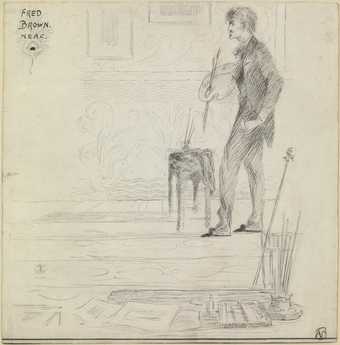
Aubrey Beardsley
Professor Fred Brown (1892)
Tate
This room introduces the key figures in BeardsleyŌĆÖs life. The glowing article in The Studio and his success with Le Morte Darthur had brought him into the public eye at the age of 20. Following this, a sequence of fortuitous meetings with leading cultural figures of the day led him to the heart of avant-garde literary and artistic circles in 1890s London.
Witty, talented and well-read, he was rapidly taken up by a group of young artists and writers who identified as aesthetes, acutely sensitive to art and beauty. These included the portrait painter William Rothenstein; Max Beerbohm, the essayist and caricaturist; and the art critic and dealer Robert Ross, the friend and former lover of Oscar Wilde. BeardsleyŌĆÖs fame grew with the publication of his illustrations to WildeŌĆÖs │¦▓╣▒¶┤Ū│Š├® in 1894 and his involvement in the fashionable magazine The Yellow Book, a period addressed in the following room. At this point his group of friends began to expand rapidly. But with the fall of Wilde early in 1895, Beardsley moved first to Dieppe, and thereafter spent little time in England.
In his last years his circle included fellow contributors to The Savoy magazine: the poets W.B. Yeats and Arthur Symons and the painter Charles Conder. The wealthy French-Russian poet and writer Marc-Andr├® Raffalovich became an important supporter and patron. His most significant friend in this period was Leonard Smithers, his endearing but unscrupulous publisher.
His mother and sister Mabel were constants throughout his brief life. They were with him when he died at Menton on the French Riviera in 1898.
This room nods to BeardsleyŌĆÖs orange and black decoration scheme in the Pimlico house that he and Mabel owned briefly in 1894. ŌĆśOrang├®ŌĆÖ was famously described as the chief decadent colour by Joris-Karl Huysmans in the novel A Rebours (Against Nature), which may have informed BeardsleyŌĆÖs choice.
The Yellow Book
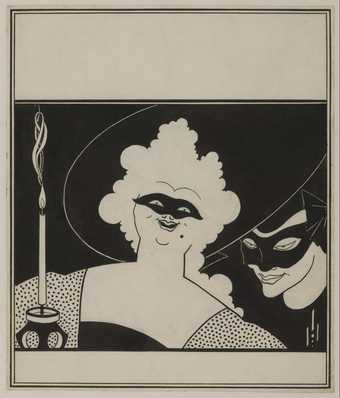
Aubrey Beardsley
Cover Design for ŌĆśThe Yellow BookŌĆÖ Vol.I (1894)
Tate
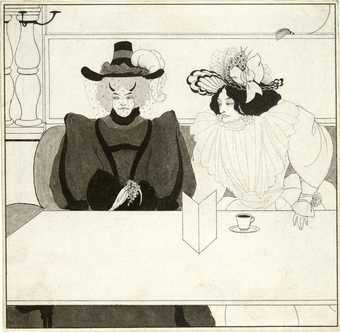
Aubrey Beardsley Black Coffee 1895. Harvard Art Museums/Fogg Museum, Bequest of Scofield Thayer.
In 1894, Beardsley became art editor of The Yellow Book, a magazine that would become the most iconic publication of the decade. Its distinctive appearance immediately set the tone. Yellow was fashionable, urban, ironic and risqu├®, recalling the yellow wrappers of popular French ŌĆśeroticŌĆÖ novels. The first volume was an instant and controversial success. Notably, it put art and literature on an equal footing. But it was BeardsleyŌĆÖs drawings that stole the show and gave the magazine its avant-garde reputation. Their bold style and daring modernity received praise and scorn in equal measure. With each new volume, his notoriety increased. To many, the publication embodied the decadent spirit, and, as one critic observed, ŌĆśto most, Aubrey Beardsley is the Yellow Book.ŌĆÖ
However, BeardsleyŌĆÖs meteoric success was short-lived. In 1895, Oscar Wilde was put on trial for sexual relationships with men and prosecuted for ŌĆśgross indecencyŌĆÖ. As the scandal tore through London, the backlash turned towards the notorious magazine and its audacious art editor. In the public mind, Beardsley was already connected to Wilde through his │¦▓╣▒¶┤Ū│Š├® illustrations. When Wilde was seen at his arrest carrying a yellow book (in fact a French novel, not The Yellow Book), the link between the author and the artist was damning. Outraged crowds broke the windows of the publishing house. John Lane, the publisher, succumbed to pressure and sacked Beardsley.
The Savoy
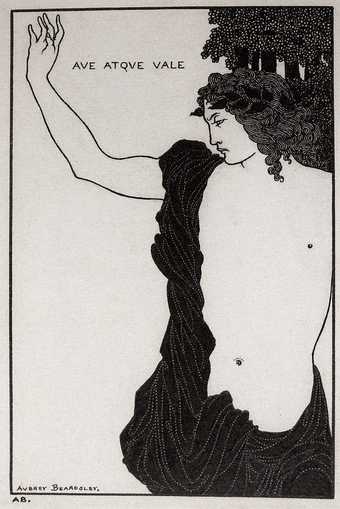
Aubrey Beardsley Ave Atque Vale 1896. Private Collection.
Dismissed from The Yellow Book, Beardsley faced the loss of his income and a newly hostile atmosphere in London. Despite his international fame, his financial situation was precarious, and he was forced to sell his house. Beardsley left England for Dieppe, the favourite French seaside resort of English writers and artists. There he encountered Leonard Smithers, an enterprising publisher (and occasional pornographer). Smithers proposed starting a new magazine to rival The Yellow Book.
With Beardsley as art editor and the poet Arthur Symons in charge of literature, The Savoy was launched in 1896, at first as a quarterly. After two issues, Smithers - perhaps unwisely - decided to publish monthly. The consequent strain on his resources meant that The Savoy folded after just a year. However, over just eight numbers it became one of the most significant and most beautifully produced ŌĆślittle magazinesŌĆÖ of the period.
The Savoy was published in Britain, but social and artistic conservatism were on the rise there following WildeŌĆÖs trial. Smithers was the only publisher who would print work by Wilde or Beardsley at this time. Some booksellers, like W.H. Smith, refused to display works by Beardsley in their windows. W.B. Yeats famously declared that The Savoy had valiantly waged ŌĆśwarfare on the British public at a time when we had all against usŌĆÖ.
The Rape of the Lock
Beardsley was a great admirer of the poet Alexander Pope (1688ŌĆō1744). Oscar Wilde had ridiculed his poetic taste, claiming ŌĆśthere are two ways of disliking poetry; one way is to dislike it, the other is to like PopeŌĆÖ.
Yet in 1896 Beardsley embarked on the illustration of his mock-epic poem The Rape of the Lock (1712).
In PopeŌĆÖs title, the word ŌĆśrapeŌĆÖ is used in its original sense of theft or abduction, rather than referring to sexual assault. The poem makes fun of a real incident during which Lord Petre (renamed ŌĆśthe BaronŌĆÖ) cut off a lock of the hair of Arabella Fermor (ŌĆśBelindaŌĆÖ in the poem) without her permission, causing a feud between their families.
Inspired by the linear intricacies of French 18th-century copper-plate engravings, which he admired and collected, Beardsley developed a new, highly decorative style. The title page amusingly credits him as having ŌĆśembroideredŌĆÖ the illustrations.
This is the first time that so many of the original drawings for the book have been exhibited together.
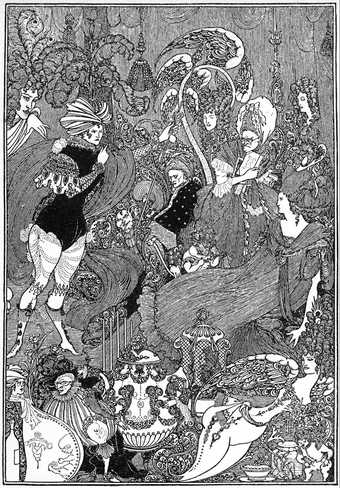
Aubrey Beardsley The Cave of Spleen (Illustration to Alexander Pope's "The Rape of the Lock") 1896 Museum of Fine Arts, Boston. William Sturgis Bigelow Collection
Mademoiselle de Maupin
Beardsley worked on illustrating Th├®ophile GautierŌĆÖs novel Mademoiselle de Maupin (1835) for Leonard Smithers between February and October 1897. The hero of the story, DŌĆÖAlbert, searches for the ŌĆśperfectŌĆÖ woman. Instead he becomes overwhelmingly drawn to a young man. The object of his desire is eventually revealed to be Madelaine de Maupin, a woman who doesnŌĆÖt conform to gender expectations of the day, particularly through dress, and is attracted to both men and women. The plot reflects on an ideal unification of male and female attributes, a widely discussed idea in literary and artistic circles in 19th-century Europe.
In his preface, Gautier promoted ŌĆśart for artŌĆÖs sakeŌĆÖ. This would become the doctrine of the aesthetic movement, which developed in the late 19th century to promote beauty over meaning or morality in art. DŌĆÖAlbert and de MaupinŌĆÖs sexual encounter is described in terms of aesthetic perfection. However, de Maupin leaves DŌĆÖAlbert immediately afterwards.
Beardsley used watercolour in his drawings to create a new softer decorative style. His friend Robert Ross suggested that this technique was ŌĆśless demandingŌĆÖ at a time when his health was in rapid decline. But Beardsley later reverted to a more detailed approach, showing that he was simply exploring new modes of expression.
'Curiosa'
While recuperating in the south of England during the summer of 1896, Beardsley began his two most explicit series of drawings yet. These were both inspired by classical sources. The first was a set of eight designs for the Ancient Greek comedy, Lysistrata, by Aristophanes. In this famous satirical play, Athenian and Spartan women bring an end to conflict by refusing to have sex with their warring menfolk until there is peace between their two cities. BeardsleyŌĆÖs other, equally outrageous set of drawings was made for JuvenalŌĆÖs Sixth Satire, a misogynistic attack on the morals and sexual habits of the women of Ancient Rome.
These subjects chimed with BeardsleyŌĆÖs own irreverent humour and fascination with all aspects of sexuality ŌĆō and, perhaps, his own sexual frustrations. Smithers, who prided himself that he would ŌĆśpublish what all the others are afraid to touchŌĆÖ, no doubt encouraged him. Matching the exuberant eroticism of the texts, Beardsley adopted a starkly linear style for these drawings. This bold new direction was inspired by his knowledge of Ancient Greek vase painting and Japanese erotic prints.
Very few of BeardsleyŌĆÖs contemporaries would have known of these drawings. Their ŌĆśindecencyŌĆÖ meant they could not be published and advertised in the usual way. Instead they were only made available by Smithers to a select group of like-minded collectors through private subscription. Even so, Beardsley seems to have had second thoughts, perhaps prompted by his growing Catholic faith. On his deathbed, he wrote to Smithers imploring him to destroy all his ŌĆśobscene drawingsŌĆÖ, a request that Smithers ignored.
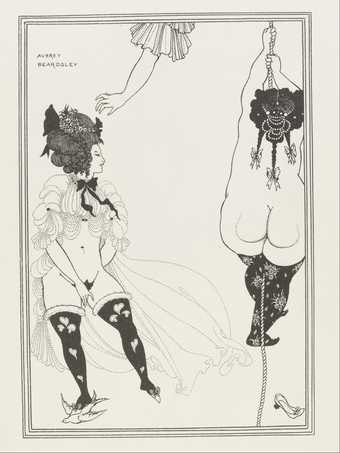
Aubrey Beardsley Two Athenian Women in Distress 1896 Victoria and Albert Museum (London, UK)
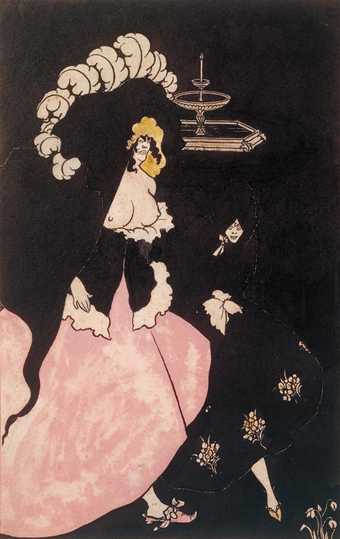
Aubrey Beardsley
Messalina and her Companion (1895)
Tate
Epilogue
After a wild spur-of-the-moment trip to Brussels in the spring of 1896, Beardsley suffered a much more severe haemorrhage of the lung from which he never fully recovered. Painfully aware of his own mortality, he moved from place to place in search of the ŌĆśhealthierŌĆÖ air his doctors advised. Though the advance of his condition was relentless, with each change of location came new inspiration. His final years are characterised by a pattern of enthusiastically taking up new projects only to grow tired and abandon them. While his focus and energy gradually diminished, his late works show that his ambition, intellect, imagination and technical power did not.
Beardsley died in Menton in the south of France on 16 March 1898. He was 25 years old. As his friend Robbie Ross commented: ŌĆśthere need be no sorrow for an ŌĆ£inheritor of unfulfilled renown.ŌĆØ Old age is no more a necessary complement to the realisation of genius than premature death. Within six yearsŌĆ” he produced masterpieces he might have repeated but never surpassed.ŌĆÖ
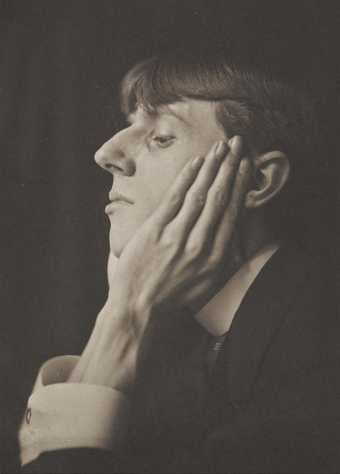
Frederick Evans Aubrey Beardsley 1893 Wilson Centre for Photography (London, UK)
After Beardsley - the early years
The fall of Oscar Wilde was a blow from which the decadent artistic and literary world of the ┤┌Š▒▓į-╗Õ▒-▓§Š▒├©│”▒¶▒ never fully recovered. But it was BeardsleyŌĆÖs death in 1898 that truly marked the end of an era. His friend Max Beerbohm caught this mood when he wrote of himself, ŌĆśI belong to the Beardsley periodŌĆÖ.
BeardsleyŌĆÖs drawings had been much imitated in his lifetime. Following his death, many young illustrators sought to step into his shoes. They worked in his style or, in some cases, made deliberate forgeries of his work. Few approached his skill as a draftsman or the rich fantasy of his imagination. Gathered here are some notable exceptions.
Collected editions of BeardsleyŌĆÖs drawings published after his death brought his work to an even wider audience. Alongside the illustrations to his most famous books, these included many of his drawings previously printed only in ephemeral publications. His designs proved influential for artists not only in Britain, but also throughout Europe and in Russia and Japan.
After Beardsley - the Sixties
In the early part of the 20th century, most of BeardsleyŌĆÖs contemporaries were forgotten and their work dismissed as having no value in the modern world. But BeardsleyŌĆÖs work continued to feel relevant for many younger artists, and in the 1960s a more widespread rediscovery of ŌĆśVictorianaŌĆÖ gathered force.
A major 1966 Beardsley exhibition at the Victoria and Albert Museum caught a rising tide of interest in 19th century art in general and especially in the fin de si├©cle. The show attracted a young audience. In BeardsleyŌĆÖs drawings they discovered ideas that chimed with their own anti-establishment values. His images provided the perfect back-drop for experimental, ŌĆśalternativeŌĆÖ lifestyles.
BeardsleyŌĆÖs drawing style played a major part in the popular Art Nouveau revival. It found its way into posters and record-sleeves and psychedelic underground magazines such as Oz. It even influenced more mainstream advertising, commercial design and interior decoration. BeardsleyŌĆÖs images seemed to be everywhere.
BeardsleyŌĆÖs strange, long-haired figures in extravagant costumes also had an impact on 1960s fashion. New, independent clothing boutiques sprang up to meet the demands of ŌĆśliberatedŌĆÖ young women and a new breed of ŌĆśmale peacocksŌĆÖ. Their clothes reflected their rejection of convention. Just as in ŌĆśthe Beardsley periodŌĆÖ, style and image were once again an essential expression of a subversive, counter-cultural sensibility.

